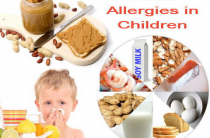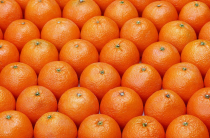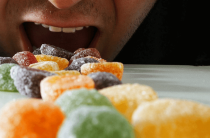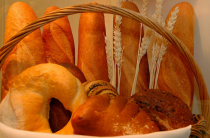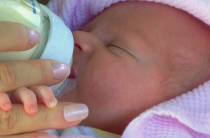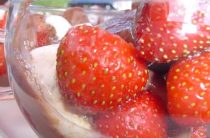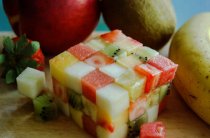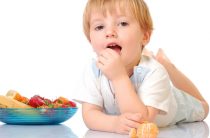From the first years of a child's life, parents need to carefully select food for him and monitor any reactions of the body. After all, his body is quite vulnerable, does not have a stable immune system. Failure to comply with such measures often leads to a disease such as food allergies.
Untimely access to the hospital for help will lead to its severe form and the development of chronic gastrointestinal diseases in the baby.
Characteristic signs of the disease in children
Symptoms of food allergy are quite diverse in their manifestations and localization. Often this disease occurs in children under one year old. The work of the digestive tract is immediately disrupted:
- Lack of appetite;
- Vomit;
- Liquid stool;
- constipation;
- Bloating and colic in the stomach.
Such symptoms are manifested as a result of irritation of the intestinal mucosa by various allergens that enter the body with food. If these signs are ignored, stomach ulcers form in children, which will accompany and torment them throughout their lives. The state of the microflora is disturbed and you can get a disease such as dysbacteriosis, which will lead to poor absorption of useful components.
As for the skin, they are covered with red spots with clear outlines. The so-called hives. Its locations are different: face, arms, torso, all over the body. Pimples can reach 12 cm in size. All this is accompanied by severe itching, and in some cases, burning. Papules may form in front of the eyes and around the mouth. Rarely, the blisters fill with fluid.
Among the lesions of the respiratory symptoms are found such as nasal congestion, runny nose, redness of the eyes, watery eyes, coughing fits. Rarely, bronchial asthma can develop. It is worth noting that a symptom such as Quincke's edema carries a special danger to the life of the baby. It develops in minutes. Various organs and parts of the child's body swell. This is provoked by the excretion of fluid into the subcutaneous tissue. Beware of swelling of the larynx, throat, tongue, palate. These organs acquire an unnatural shape and a huge size, blocking the access of air to the lungs. In turn, this leads to asphyxia.
food allergy triggers in children
The very first reason for the appearance of such a disease as a food allergy in a child is the malnutrition of the mother at the time of bearing the baby and breastfeeding it. During this period, the use of citrus fruits, some fruits, and seafood is prohibited.
Do not introduce complementary foods to your child too early. Pediatricians advise doing this no earlier than from the age of seven months and in very small doses. Artificial mixtures in 90% of cases give such an allergic reaction as vomiting and urticaria. Very carefully accustom the child to vegetable purees. Start first with green and white vegetables. Fruits are given last. Manifestations of food allergies may indicate the presence of infectious diseases in the newborn. Symptoms also occur when various spices are present in the dish.
Particular attention should be paid to the psychological factor of the onset of the disease. At the subconscious level, a sad experience of contact or consumption of one or another type of fruit or vegetable is laid, and when it is re-contacted, all the symptoms appear. These products can cause unpleasant associations in the child, which later provoke an allergy.
A food allergy in a child occurs against the background of the use of the following products:
|
|
|
All these products should be used with extreme caution in children under four years of age. After all, their body does not yet have the ability to recognize foreign proteins and the correct response to their intake.
Treatment of food allergies with medications
We do not advise you to self-medicate the child. It is imperative to contact an allergist or pediatrician. The doctor will prescribe the necessary tests to identify the allergen product. As a rule, these are skin tests and a blood test. After that, the right treatment has already been selected. The complex of therapy involves the use of various antihistamines, creams and ointments of local action. It should be borne in mind that they are selected individually for each child and his age. Here are some of the tools that are used:
|
|
|
Often doctors resort to the use of immunotherapy. Its essence is to introduce a small amount of the allergen under the skin. Such manipulations contribute to the development of immunity and antibodies, after which the body ceases to react so violently to certain foods. But such treatment takes a very long time (up to two years) and requires periodic stays in the hospital for injections (3-4 times a week).
Treatment of newborns
The treatment of infants consists mainly in the observance of a strict diet by the mother. Restrictions should be in everything: vegetables, fruits, cereals, meat dishes. Nothing fried or smoked. Everything is steamed or boiled. Dietary meats can be baked in the oven. If a child is allergic to breast milk, it is worth starting artificial feeding with the help of Nestle and Humana hypoallergenic mixtures.
In acute manifestations of the disease, of course, you need to use antihistamines. You can apply Fenistil in drops. The tool perfectly relieves redness of the skin and their itching. Normalizes the work of the digestive tract. It is allowed already from the age of one month, a few drops a day, diluted in milk, depending on the complexity of the position of the baby.
Suprastin is also considered safe. Also allowed for children under the age of one month. In a short period eliminates the symptoms of food allergies. It belongs to the drugs of the first generation, so it is better to use it in the initial stages of the disease. In case of an overdose, multiple adverse reactions may occur. Good product Zyrtec. You can give babies from 6 months. It belongs to the third generation antihistamines, therefore it has a minimal list of contraindications and side effects. A fairly large selection among creams and ointments for allergic urticaria used by newborn children:
|
|
Treatment of children older than 1 year
To treat food allergies in children 1 to 3 years old, you can use the following antihistamines:
| Diphenhydramine | High-quality drug of the first generation. It has antipruritic, anti-allergic properties. Effectively fights inflammatory processes in the body. Not for use by children under two years of age. |
| Diazolin | The drug is allowed to be used for a long time. Copes with rhinitis, urticaria, Quincke's edema, disorders of the gastrointestinal tract. Allowed for children under one year old. |
| Astemizol | Fights allergic manifestation of rhinitis and urticaria. It is prescribed for food allergies and hay fever. Fast acting tool. Designed for babies after two years. |
| Claridol | Prevents the production of histamine in cells. Relieves symptoms of the disease within half an hour after taking the drug. It is possible to treat a disease such as food allergies in children with a remedy, starting from 2 years. |
| Lomilan | The drug is prescribed for any allergic manifestations. Children are prescribed from the age of two. Among the adverse reactions noted are: dry mouth, dizziness, drowsiness. |
As for topical preparations, you can use a cream such as Fucidin. It has an antibacterial property, promotes healing of wounds from combing urticaria. It is applied to the skin in a thin layer, does not cause burning. It is recommended to apply three times a day, regardless of the age of your baby. Levomekol ointment is used already at an advanced stage of allergic urticaria, so it can be applied to large areas of the skin. If you choose among hormonal agents, then Advantan will be the best for children. Available in the form of ointment, emulsion and cream. Use in children should not exceed two weeks. Effective in all forms of dermatitis, Quincke's edema. The safe age of children for its use is not earlier than one year. Drapolen and Godrocortisone ointment have an antiallergic effect.
Treatment of children after the age of three
For the treatment of food allergies in children of this age, you can use all of the above drugs. To them, you can add the following, with a stronger effect and speed of action:
- Pheniramine. Copes with both skin and respiratory manifestations of allergies. Safe for children over three years old.
- Terfenadine. Blocks the production of histamine. Relate to second generation drugs. Contraindicated in children under three years of age.
For the treatment of a baby, you can also use more well-known antihistamines such as Tavigil, Fenkarol, Setastin. Take care of the rapid removal of toxins from the body of your child. For this, it is necessary to take various sorbents: activated carbon, white coal, Atoxil, Enterosgel. Let your child drink plenty of water, do not let fluids stagnate in the body. To get rid of rhinitis, take nasal rinses. They are absolutely safe in any childhood and have no adverse reactions. They are based only on sea salt and water. For example, Aqua Maris, Aqualor, Humer, No-salt and others. These drugs will help restore the nasal mucosa and moisturize it.
Traditional medicine recipes
In the treatment of a child, there must be a very delicate approach. Populists advise, if the baby does not suffer from an allergy to honey, use honeycombs. Let him chew these bee products during the day. Such treatment takes a lot of time, but is effective for food allergies. It is not bad to relieve symptoms of dandelion juice, and specifically their leaves, and water. The proportions should be 1:5. Give one spoonful of this juice to the baby before meals.
Chamomile baths will help eliminate the manifestations of urticaria and restore the structure of the skin. Brew chamomile flowers in 0.5 liters of boiling water. Let it brew for about an hour and then add it to your baby's bath. Taking such baths costs from 10 to 15 minutes. You can add oak bark. Make vegetable juices more often. They are considered diuretics, so they will help get rid of toxic substances in the body in a short time. For use carrots, parsley, celery, cucumber and beets.
You can also prepare infusions in the form of tea from the following plants:
- Nettle;
- strawberry leaves;
- Mint;
- succession;
- Black currant.
Prepare a drink from rose hips and bay leaves. To do this, brew these ingredients (200 g of berries and several sheets of bay tree) in a thermos and insist for several hours. Then give your child a couple of sips throughout the day, preferably before meals.
To relieve skin manifestations, you can use folk recipes for ointments. It will take 70 ml of infusion of their succession and 25 g of petroleum jelly. Mix all this thoroughly, turning it into a homogeneous mass, and smear the affected skin twice a day. Rice starch mixed with glycerin helps well. If you still decide to take Vaseline as a basis, then you can add simple aloe juice to it. A string can be used together with sunflower oil or animal fat.
Ointments based on medicinal herbs help well:
- Two pinches of dry crushed elecampane and five tablespoons of lard.
- Vaseline and birch tar. Everything is taken in the amount of 20 grams.
- White clay, chamomile, dry lavender leaves, baby powder, water.
One of the most useful traditional medicine is mummy. One tablet of mummy is diluted in a liter of water. Let your child drink 100 grams every morning with warm milk.
Baby diet
To completely get rid of such a disease as a food allergy in a child, it is necessary to follow a strict diet. If you are allergic to milk, it is strictly forbidden to eat dishes with its use. You can replace this product with its soy substitute, sometimes it is allowed to give goat's milk. Babies need to be fed with hypoallergenic mixtures. The protein that is included in their composition has gone through a huge processing cycle, which allows us to consider it safe.
If an allergy arose against the background of the use of citrus fruits, they should be discarded. Do not eat strawberries, raspberries, kiwi, black currants. To replenish the required amount of vitamins in the body, give your child apples, pears, plums. And so with every type of food allergy - the rejection of a provocative product.
There is a basic diet, which will require the restriction of the baby in the use of fish, chocolate, meat, fried foods, bread, vegetables. To cook potatoes, you need to pre-soak them for several hours. This will save him from a large amount of starch, which serves as an allergen for the child's body. From meat it is allowed to eat only beef, turkey and rabbit meat. But chicken meat should be avoided. For its preparation, use only double boilers and ovens. You can bring the meat to heat treatment by boiling.
When your child's well-being improves, introduce broths into the diet: vegetable and meat. The daily use of various cereals will be very useful. Boiled tuna is perfectly perceived by the body - this is the only hypoallergenic fish. Over time, feed your baby small portions of unflavoured cottage cheese and yogurt. The use of preservatives and dyes is unacceptable. Despite all the beneficial properties of carrots and pumpkins, these vegetables are introduced last, after removing all the symptoms of the disease.
This is what a child's daily diet might look like:
- Breakfast - boiled rice with a steam cutlet, dried fruit compote.
- Lunch - buckwheat porridge with meatballs, cabbage and cucumber salad with olive oil, weakly brewed green tea.
- Snack - a baked apple.
- Dinner - boiled fish, beetroot salad, a glass of kefir.
It will be useful to keep a food diary, where you need to make each meal, in what quantity, time of intake, and possible allergic manifestations. This will help parents and the doctor to identify the possible cause of the disease and immediately begin a course of treatment.
How to protect your child from food allergies?
Food allergy in a child is a dangerous and unpredictable disease. Therefore, in the first years of life, it is necessary to be extremely attentive to various manifestations on the part of the baby's body. To keep it safe, follow these instructions:
- Make sure your child doesn't overeat.
- Limit the baby in the use of sweets and fruits.
- Prepare only fresh food daily. Do not leave the dish for the next day.
- Engage in hardening - give the child to any sports section.
- Try to eat less too acidic vegetables and fruits.
- Use only olive, sesame or linseed oil.
- Cook for a couple, so the product will retain all its beneficial properties.
- Take fractional meals as a rule.
- Diversify the menu.
